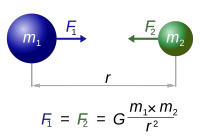








Isaac Newton explained the workings of the universe through mathematics. He formulated laws of motion and gravitation. These laws are math formulas that explain how objects move when a force acts on them. Isaac published his most famous book, Principia, in 1687 while he was a mathematics professor at Trinity College, Cambridge. In the Principia, Isaac explained three basic laws that govern the way objects move. He then described his idea, or theory, about gravity. Gravity is the force that causes things to fall down. If a pencil falls off a desk, it will land on the floor, not the ceiling. In his book Isaac also used his laws to show that the planets revolve around the suns in orbits that are oval, not round.
Isaac Newton used three laws to explain the way objects move. They are often call Newton’s Laws. The First Law states that an object that is not being pushed or pulled by some force will stay still, or will keep moving in a straight line at a steady speed. It is easy to understand that a bike will not move unless something pushes or pulls it. It is harder to understand that an object will continue to move without help. Think of the bike again. If someone is riding a bike and jumps off before the bike is stopped what happens? The bike continues on until it falls over. The tendency of an object to remain still, or keep moving in a straight line at a steady speed is called inertia.
The Second Law explains how a force acts on an object. An object accelerates in the direction the force is moving it. If someone gets on a bike and pushes the pedals forward the bike will begin to move. If someone gives the bike a push from behind, the bike will speed up. If the rider pushes back on the pedals the bike will slow down. If the rider turns the handlebars, the bike will change direction.
The Third Law states that if an object is pushed or pulled, it will push or pull equally in the opposite direction. If someone lifts a heavy box, they use force to push it up. The box is heavy because it is producing an equal force downward on the lifter’s arms. The weight is transferred through the lifter’s legs to the floor. The floor presses upward with an equal force. If the floor pushed back with less force, the person lifting the box would fall through the floor. If it pushed back with more force the lifter would fly into the air.
When most people think of Isaac Newton, they think of him sitting under an apple tree observing an apple fall to the ground. When he saw the apple fall, Newton began to think about a specific kind of motion—gravity. Newton understood that gravity was the force of attraction between two objects. He also understood that an object with more matter –mass- exerted the greater force, or pulled smaller object toward it. That meant that the large mass of the earth pulled objects toward it. That is why the apple fell down instead of up, and why people don’t float in the air.
Isaac Newton thought about gravity and the apple. He thought that maybe gravity was not just limited to the earth and the objects on it. What if gravity extended to the moon and beyond? Isaac calculated the force needed to keep the moon moving around the earth. Then he compared it with the force the made the apple fall downward. After allowing for the fact that the moon is much farther from the earth, and has a much greater mass, he discovered that the forces were the same. The moon in held in an orbit around earth by the pull of earth’s gravity.
Isaac Newton’s calculations changed the way people understood the universe. No one had been able to explain why the planets stayed in their orbits. What held them up? Less that 50 years before Isaac Newton was born it was thought that the planets were held in place by an invisible shield. Isaac proved that they were held in place by the sun’s gravity. He also showed that the force of gravity was affected by distance and by mass. He was not the first to understand that the orbit of a planet was not circular, but more elongated, like an oval. What he did was to explain how it worked.